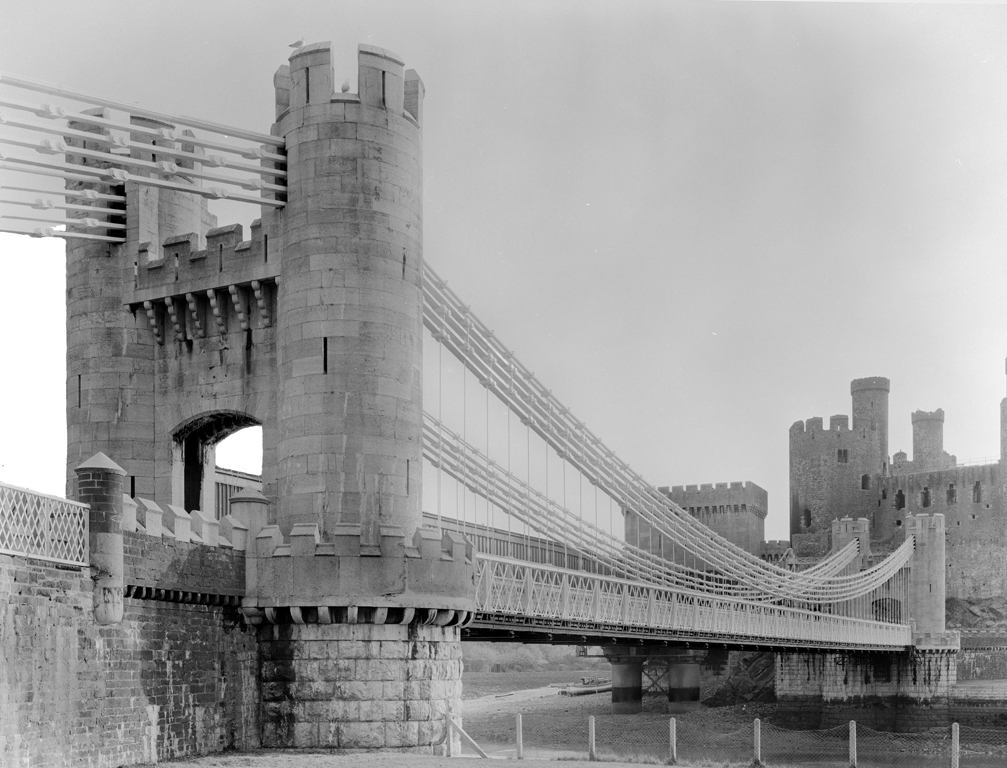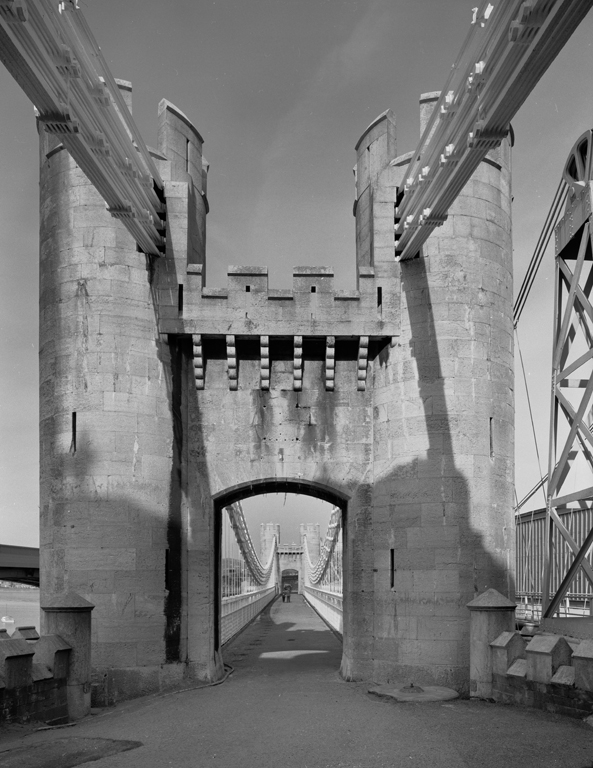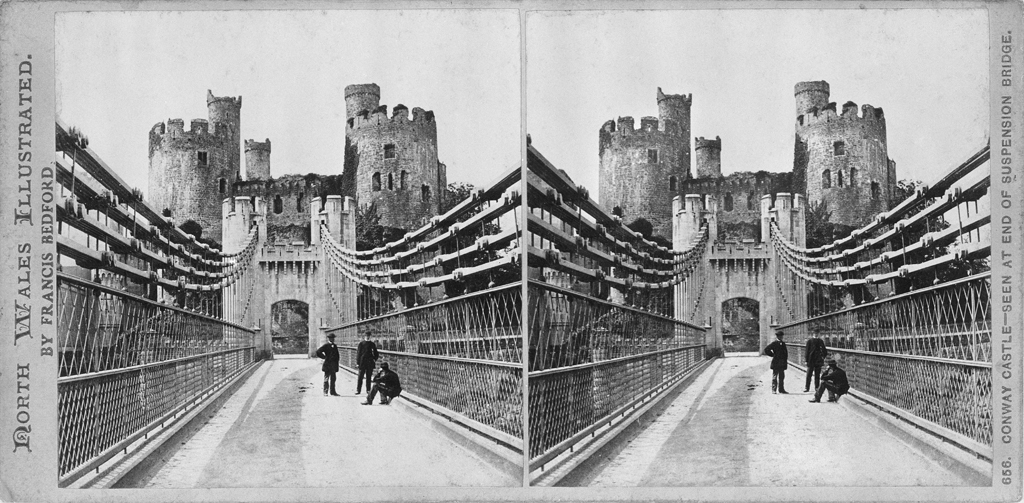Conwy Suspension Bridge - Overview
Thomas Telford’s suspension bridge, built between 1822 and 1826 to carry the London - Holyhead Road across the river Conwy, is one of the oldest of its kind still in existence to date. The bridge measures 99.5m in length, with a road deck suspended from on two sets of fours chains from two battlemented towers. In designing his bridge, Thomas Telford took inspiration from the adjacent Conwy Castle and town walls so that the modern bridge would blend in harmoniously with the Norman architecture dominating the site. The bridge keeper’s single-room lodge likewise copies the Norman style of the castle. Before granting passage, this keeper would collect a toll stipulated by the mode of travel on foot, horse or in a carriage. The original wooden deck was replaced by an iron roadway in 1896, and in 1904 a pedestrian walkway was temporarily added to the north side of the bridge.
Whereas the bridge formerly allowed horse carriages safe passage across the river, since the building of the new road bridge in 1958 it has been used only for pedestrian traffic. In 1965 it came under the care of the National Trust, and in 1981 the Toll Keepers cottage was listed as Grade I by Cadw.
Travelling through Wales shortly after the suspension bridge was finished, its elegant design reminded the French writer Basil-Joseph Ducos of fishing nets hung up to dry in the wind and he felt quite transported into a fairy tale.
Accounts of Travel
"v. Yelin.", 1825
Julius Konrad Ritter von Yelin (1771 – 1826)
In Conway ist so eben eine eiserne Kettenbrücke über den in Winterzeit gefährlichen Conway im Baue begriffen, welche von einem neuen Steindamme, mit etwa 200’ Spannweite, nach den prächtigen Ruinen des alten Kastells hinüber führen wird. Die genaue Besichtigung aller einzelnen, erst im Zusammensetzen begriffenen Kettenteile, gewährte uns grossen Gewinn ....
An iron chain bridge spanning circa 200 feet is currently being built across the River Conwy, so treacherous during winter time, from the new stone embankment to the ruins of the old, magnificent castle. The meticulous inspection of all chain links still under construction gave us great pleasure ....
Medicinische Reisebriefe aus England und Holland: 1866 und 1867, 1866
Heinrich Rohlfs (1827 – 1898)
Auf den nach Conway fahrenden Zug brauchten wir nich lange zu warten. Diese alte Stadt liegt an dem Flusse Conway, von den Römern Conovius genannt und ist eine der ältesten Städte von Wales. Schon Tacitus erwähnt der civitas Congorum. Wenn man von Llandudnojunction, wo der eine Zug nach Chester abgeht, auf der nach Irland hin führenden Bahn sich Conway nähert, so wird man bewältigt von dem majestätischen Anblick der alten Ruine. Im Hintergrunde die hohen, waldbekränzten Walesschen Gebirge, erhebt sich unmittelbar aus dem Meere die ehrwürdige Burg; sie erscheint noch so stattlich, daß man in der Ferne glauben könnte, man nähere sich einem noch ziemlich gut erhaltenen Ritterschloß. Die Stadt Conway selbst verschwindet vor der monumentalen Größe der auf einem hohen Felsen sie überragenden Burg. ...
Zwei majestätische Brücken führen über den hier in den Conwaybusen sich ergießenden Conwayfluß. Welche Contraste! Feiert hier nicht das Mittelalter seine Vermählung mit dem neunzehnten Jahrhundert? Ist es nicht wunderbar, daß die tubular-bridge durch einen Theil der Ringmauern des alten Castells hindurchführt?
In Llandudnojunction waren wir ausgestiegen, um die Wagen zu wechseln und gelangten in circa 10 Minuten nach Conway. Ein breiter Fahrweg brachte uns nach der suspension-bridge. Dieselbe ist ein großartiger Prachtbau und von dem genialen Telford 1822 erbaut. Zu unserer Linken ließen wir die tubular-bridge, die von dem berühmten Ingenieur Stephenson erbaut und im Jahre 1848 zuerst befahren wurde. Sie dient nur zu Eisenbahnzügen ist ganz geschlossen und erscheint daher dem Auge als ein eiserner, viereckiger tubus.
We did not have to wait long for the Conwy-bound train. This old town is situated on the River Conwy, formerly called Conovious by the Romans, and is one of the oldest towns in Wales. As early as Tacitus there is mention of the civitas Congorum. Approaching Conwy on the Ireland-bound railway from Llandudno Junction, where the other train departs for Chester, one is overwhelmed by the majestic sight of the old ruin. With the forest-covered Welsh mountains rising in the background, the venerable castle rises immediately from the sea; it still appears so formidable that from a distance it is as if one were approaching a fairly well-preserved knight’s castle. The town of Conwy itself vanishes beneath the monumental proportions of the castle towering above it from its high rock. ...
At this spot, two majestic bridges cross the estuary into which the River Conwy flows. Such contrast! Are the Middle Ages and the nineteenth century not wed here? Is it not wonderful how the tubular bridge partially penetrates the outer wall of the old castle?
We had alighted at Llandudno Junction in order to change coaches and arrived at Conwy ten minutes later. A broad road brought us to the suspension bridge. It is a grand, magnificent building, constructed by the ingenious Mr Telford in 1822. To its left we beheld the tubular bridge that had been built by the famous engineer Stephenson and was first opened for traffic in 1848. It only serves railway trains and therefore takes the shape of a small, quadrangular tube.
Itinéraire et souvenirs d’Angleterre et d’Ecosse, 1814-1826, 1826
Basile-Joseph Ducos (1767 – 1836)
De loin, il ressemble à un filet que des pêcheurs auraient étendu pour le sécher; mais en approchant, on distingue bientôt les chaînes qui le portent. Liés entre eux par des charnières, les anneaux dont elles se composent, suivraient au besoin les inflexions que la pesanteur leur imprimerait. Des tiges verticales y sont attachées par des écrous, et tiennent dans le bas, de la même manière, aux solives d’une chaussée factice qu’un intervalle de dix-huit pieds sépare du niveau de la haute mer. Le calcul a réduit l’emploi de la matière à sa plus simple expression. Une savante distribution des forces en déguise l’intensité. La résistance ne se présente que sous des formes souples et gracieuses. De chaque côté un trottoir est réservé pour les piétons. Les voitures passent au milieu. Quels que soient leur poids et leur vitesse, elles ne causent ni ébranlement, ni oscillation à cet ouvrage si flexible en apparence. En même temps de petites barques voguent au-dessous avec d’autant plus de sûreté et de facilité, que le resserrement des courants n’y entretient pas moins de quinze à vingt-quatre pieds d’eau, selon que la marée est basee ou haute. Ce voyage presque aérien au travers d’un golfe, entre la mer et des montagnes d’un aspect sévère, sur une route qu’on croirait si fragile, au bruit des vagues que les goëlands caressent de leur aile rapide, a quelque chose de romanesque et de hardi qui plaît à l’imagination. La terre-ferme est au pied du château d’Aberconway dont les tourelles gothiques ont servi de modèle à celles du pont qui n’en sont en quelque sorte qu’un ouvrage avancé.
From a distance it looks like a net that some fishermen have hung out to dry; but as you get closer you can make out the chains that hold it. The chain’s links, which act as hinges, can respond to whatever shape the weight might demand. Vertical rods are attached to them with nuts, and are connected in the same way at the bottom to the joists of a roadway, such that a gap of eighteen feet separates it from the water at high tide. Careful calculations have reduced the need for material to the barest minimum. The forces are so skilfully distributed as to mask their intensity. Any resistance is manifest only in the form of flowing, graceful shapes. Either side is a pavement reserved for walkers. Vehicles travel down the middle. Regardless of weight and speed, these do not cause tremors or rocking in this structure though it gives every appearance of flexibility. At the same time little boats sail beneath it, so much the safer and easier since the swell of the current there holds no less than fifteen to twenty-four feet of water, depending on the tide. This almost aerial journey across a gulf, between sea and severe-looking mountains, on a road that gives an impression of fragility, to the sound of waves that are caressed by the seagulls’ rapid wings, has something of the fantastic and bold about it, something that appeals to the imagination. Solid ground is reached at the foot of the castle of Aberconwy, whose Gothic turrets served as model to those on the bridge, which is in a sense just a continuation of this structure.
"Voyage au nord du pays de Galles", c. 1866
Arthur d’Arcis ( – )
Thomas Telford construisit en 1826 un pont suspendu dont les dimensions n’ont rien d’étonnant, mais qui, à l’aide de deux tours crénelées placées à chaque extrémité et d’ornements savamment disposés, se fond en une telle harmonie avec le vieux château auquel il aboutit, que l’on dirait qu’il en est le pont-levis. L’illusion est tellement forte qu’elle persiste même lorsque, après l’avoir franchi, on passe sous la vieille porte de la ville. Quant au pont du chemin de fer, construit par Stephenson en 1847, on le prendrait facilement pour un de ces ponts couverts, comme on en voit beaucoup en Suisse, et pourvu que l’on ne voie pas le train s’y engouffrer on n’éprouve pas beaucoup de peine à le mettre d’accord avec les anciennes tours au pied desquelles il débouche. Quelques mots de sa structure à la fois simple et hardie. Imaginons un énorme tube de fer à section carrée dont les extrémités sont inébranlablement établies sur de solides ouvrages en maçonnerie construits sur les deux rives de la Conway, et ajoutons que le tablier, les parois et le plafond de ce tube singulier consistent en longs tubes de fer, à section carrée aussi, soigneusement assemblés. Voilà le pont. Et, pour terminer, remarquons que celle disposition offre à tel point le minimum de poids et le maximum de résistance, que la vertigineuse malle irlandaise le traverse en toute sécurité.
In 1826 Thomas Telford built a suspension bridge whose dimensions are not surprising, but which, thanks to the two crenelated towers placed on either side and carefully placed decoration, merges so harmoniously into the old castle at the end of it, that it could be mistaken for the latter’s drawbridge. So strong is the illusion that it persists even when, having crossed it, you pass under the old gate of the town. As for the railway bridge, constructed by Stephenson in 1847, it could easily be mistaken for one of those covered bridges, as are often seen in Switzerland, and unless you see the train disappear into it, it is not difficult to reconcile it with the ancient towers at whose feet it emerges. A few words on the structure that is both simple and daring. Imagine an enormous tube of iron with square sections, whose ends are unshakeably established on solid pieces of stonework constructed on either bank of the Conwy, and add to this the fact that the roadway, wall and ceiling of this remarkable tube consist of long tubes of iron, also with square sections, assembled with great care. There you have the bridge. And to conclude, note that this disposition makes for maximum strength with minimum weight so that the swift Irish Mail crosses it in perfect safety.




